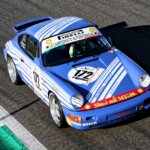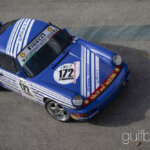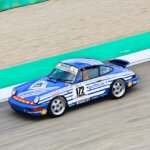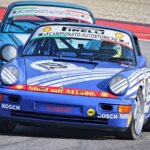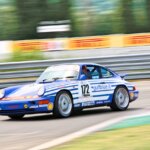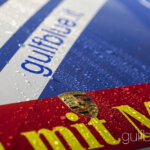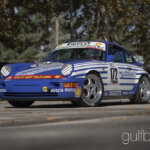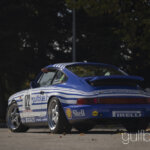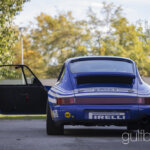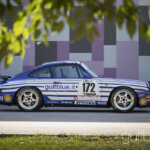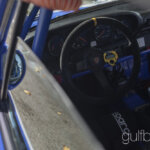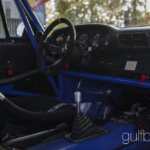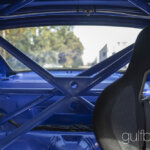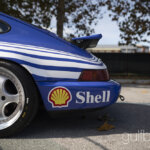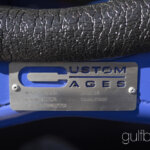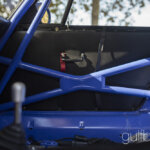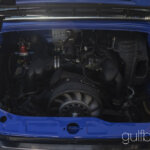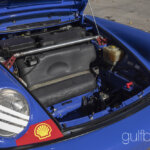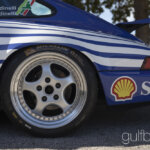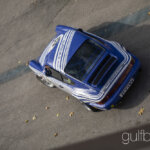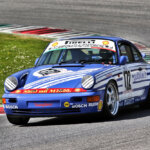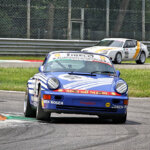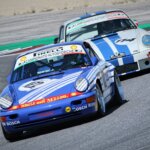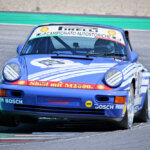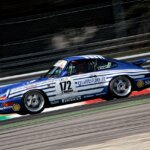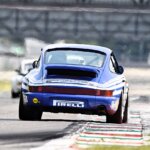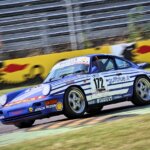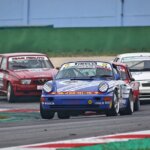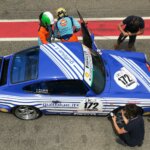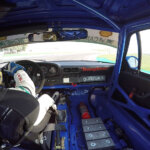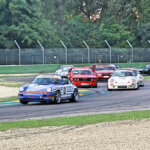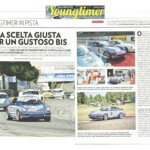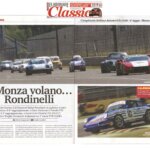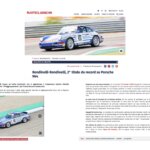CLASSIC CARS - PORSCHE 911 CARRERA 2 GR. B (CARRERA CUP), 1990
(English text below)
Porsche 911 Carrera 2 (964) Gruppo B con specifiche 1990, curatissima e da noi preparata con tanto amore, con cui abbiamo vinto il Campionato Italiano Velocità Autostoriche – IV raggruppamento – 2018 e 2019. Si tratta della più giovane delle Porsche ammesse nelle competizioni di auto storiche. Non essendo finora ammessi nelle competizioni i modelli Trofeo o Cup, l’auto segue le specifiche Gruppo B, ma si avvicina quasi in tutto alla 911 Carrera Cup, che ha iniziato la sua lunga carriera proprio nel 1990 con la serie 964.
L’auto è stata preparata dall’officina Rennsport e dal team RS Historics grazie ad un tour de force iniziato nel Gennaio 2018 partendo dalla scocca nuda, sverniciata completamente ad acqua, rinforzata con roll-bar saldato in acciaio T45 (High Tensile Carbon Manganese Steel) di Custom Cages (UK), riverniciata nel colore Maritim blue (colore originale Porsche) e riassemblata per poter correre già la prima gara del Campionato Italiano Velocità Autostoriche ad Aprile 2018.
Scocca molto leggera – soli 1110 kg -, portata al minimo ammesso in fiche (1180kg) mediante zavorra. Motore 3,6 preparato secondo il regolamento dell’epoca, con alberi a cammes profilati, bilancieri fissi, doppio radiatore anteriore, cassonetto d’aspirazione maggiorato (essendo l’aspirazione libera, è stato impiegato quello del modello 993), scarico sportivo per una soddisfacente potenza di 300cv (provati al banco). Cambio completamente rivisto per uso agonistico con coppia conica corta, adatta a tutti i circuiti (Monza e Imola compresi). Assetto sportivo su cerchi Cup scomponibili da 18” (3 set) e pneumatici Michelin slick, impianto frenante di serie (come da regolamento) con ABS, ottimizzato per gare di durata.
Impianto elettrico revisionato, batteria leggera, impianto di ventilazione funzionante, pompa ABS e servofreno revisionati, serbatoio di benzina originale con materiale anti-esplosivo e circuito per il prelievo, scatola guida senza servosterzo. Impianto d’estinzione fisso, equipaggiamento di sicurezza in corso di validità, specchietti retrovisori tipo corsa, vetri laterali discendenti ma senza meccanismo alzavetro.
Livrea adesiva ispirata a quella originariamente usata da Uwe Alzen nel campionato Porsche Carrera Cup.
L’auto ha vinto il Campionato Italiano Velocità Autostoriche 2018 e 2019 nel 4° raggruppamento (dal 1982 al 1990): in particolare il primo anno, matematicamente avrebbe anche vinto il campionato assoluto tra le Autostoriche, se tale titolo venisse assegnato. L’auto si è sempre piazzata nei primi 3 posti assoluti, vincendo sempre nel IV raggruppamento.
L’auto può essere modificata secondo specifiche Cup, eliminando la zavorra, montando l’impianto frenante anteriore maggiorato ed utilizzando cerchi da 17 pollici.
HTP FIA, regolarmente targata italiana con certificato di rilevanza storica ASI. Durante la stagione agonistica è apparta sulle principali testate del settore, destando notevole interesse. Disponibile tutta la documentazione della preparazione eseguita.
Anche questa 964 Gruppo B ha il comportamento delle 911 della vecchia guardia, con il motore posteriore a sbalzo che rende il retrotreno particolarmente “vivace” se non la si guida con rispetto: se invece si sanno prevedere le sue reazioni, la 964 sa essere una fedele complice di giri veloci in pista, grazie anche alla sua stretta silhouette ed al fondo piatto, in grado di fendere l’aria.
Frenata costante, grande stabilità sul veloce e molta coppia già dai bassi regimi compensano una certa “pesantezza” nel misto stretto. Ma la 964, nonostante i suoi 30 anni, non dimostra affatto i segni del tempo: un’auto molto divertente che richiede una buona esperienza per essere portata al limite, essendo quasi del tutto priva di ausili elettronici (tranne l’ABS).
L’auto può essere vista previo appuntamento a Bologna. Maggiori dettagli su www.gulfblue.it
NOTE STORICHE
La nuova 964 entrò nelle competizioni in sordina poiché sul finire degli anni ’80 la maggior parte delle auto da corsa erano Turismo, le GT erano quasi del tutto sparite; a Stoccarda avevano indirizzato lo sviluppo delle corse clienti sul modello 944 Turbo Cup, protagonista del campionato monomarca Porsche a partire dal 1986.
Tuttavia la clientela rimaneva legata a lei, la 911 – la sportiva con il motore teoricamente nella posizione sbagliata – ancora in grado di regalare un piacere di guida e dei risultati ineguagliabili. Così, se la versione Carrera 3.2 prodotta dal 1984 al 1988 ebbe uno scarso (per non dire nullo) uso agonistico, con la 964 la Porsche decise di correre ai ripari riportando ufficialmente la 911 negli autodromi.
La serie 964 ha segnato un’importante linea di demarcazione con il passato: pur sembrando sempre la stessa, fu riprogettata nell’87% dei suoi componenti – rispetto alla 3.2 – e le potenzialità per ben figurare c’erano tutte. A partire dalla stagione 1990 il campionato monomarca Porsche abbandonò le 944 per passare alle nuove 911 Carrera Cup: le auto destinate alla pista altro non erano che delle Carrera 2, svuotate, alleggerite, con assetto adatto all’uso sportivo, cerchi da 17’, freni maggiorati e rapporti del cambio accorciati e altri accorgimenti di stampo motorsport. Al volante delle prime Cup decine di piloti hanno riempito gli schieramenti delle piste europee dando vita ad una stagione memorabile e spettacolare. Fu la prima di 29 stagioni che ancora oggi vedono il campionato Carrera Cup dare spettacolo in tutto il mondo con lo stesso agonismo degli albori. Hezemans, Manthey, Alzen, Jarier e Beltoise sono alcuni dei nomi celebri che corsero con la 964 Carrera Cup.
Essendo la Cup un’auto costruita unicamente per il campionato monomarca, non ha mai ottenuto un’omologazione FIA e di conseguenza non ha preso parte a competizioni internazionali. Tuttavia, visti i buoni risultati ottenuti con la Cup, a Zuffenhausen il 1° settembre del 1990 decisero di omologare sia la Carrera 2 che la 4, a trazione integrale, in categoria Gruppo B.
Le normative FIA prevedevano che la 911 potesse correre unicamente in Gruppo B, con notevoli limitazioni e nessun componente specifico che differisse dalla serie (gli incidenti mortali nei rally con le Gruppo B obbligarono a restringere drasticamente il campo d’azione sulle preparazioni di queste vetture).
Nel 1990 qualche Carrera 2 ha preso parte alla 24 ore di Spa e qualche altra competizione nazionale, ma senza nessun impegno ufficiale della Casa: in Italia alcune corsero nella Targa Tricolore Porsche organizzata dal Porsche Club Italia. Le apparizioni delle Carrera 4 sono state ancora più sporadiche, limitate a qualche rally in cui le quattro ruote motrici potevano aiutare, ma il peso decisamente no.
A settembre ‘91 la denominazione RS, tornò ad affiancarsi dopo 18 anni al modello 911 Carrera: in questo caso era la trasposizione stradale della Carrera Cup, già collaudata nelle piste da due stagioni. Due lettere che hanno portato alla 964 la stessa fortuna dell’antenata, la Carrera RS del 1973, consacrandola tra le più efficaci GT per molte stagioni, evolvendosi poi in Carrera RS 3.8 ed RSR.
_____________________________________________
1990 Porsche 911 Carrera 2 (964) with Group B specs, prepared and cared with lot of love, that we drove in 2018 Italian Historic Cars Championship, winning our category. It is the youngest 911 elgible on historic races: til now Cup, Trophy and single make championship cars weren’t allowed among historic cars, so our vehicle has been prepared according to Group B specs, pretty similar to the 911 Carrera Cup, which debuted its 29 years old career in 1990 with the 964 model.
We started a “tour de force” on this car in January 2018 in order to be ready for the upcoming seasion, with the fundamental help of Rennsport workshop and RS Historic racing team: rolling chassis to bare metal, reinforced and equipped with the latest specs (T45) welded in Custom Cages rollcage, fully repainted in Maritime Blue, original Porsche paint, and fully remounted to be on the grid of the opening seasion race in April 2018.
This chassis is very very strenght and light: now the car weights 1110 kgs but the minimum admitted by Appendix J is 1180 kgs, reached with ballasts.
3.6 litre engine overhauled according to Appendix J and FIA homologatin form, with racing camshafts, fix rocker arms, double oil cooler, improved engine air intake (using 993 airbox, allowed by regulation), high performance exhaust for an output power of 300 hp (tested on the rolling dyno). Original gearbox improved for racing purpose and short final ratio suitable for almost all circuits (including Imola and Monza). Racing suspension setup based on 18 inches Cup split rims (3 sets) and Michelin tyres, standard braking system with ABS (as for App. J), improved for long-distance races.
Electrical overhauled, lightweight battery, ventilation system, ABS pump and servo assisted brake overhauled, original fuel tank with foam with collecting pot for better pickup, non servo-assisted steering box. Hand-operated extinguisher and extinguisher system, all safeties up to date, aerodynamic outside mirrors, descending side windows without mechanism.
Adhesive white-blue livery inspired to the champion Uwe Alzen’s 911 Carrera Cup.
The car won the 2018 and 2019 period J (1982 to 1990) Italian Historic Cars Championship: the first year in particular, it would have won the Italian overall championship if only existed a title, winning all races but one.
The car could be converted to Carrera Cup specs , upgrading the brake system (with drilled discs and larger brake calipers), taking off the ballast and fitting the 17 inches wheels.
FIA HTP expiring in 2028, road registered in Italy with ASI (Auto Moto Club Storico Italiano) certification. During the racing season many magazines and websites dedicated articles and mentioned the car, thanks to the originality of the project.we can send a detailed documentation of the works done.
This 964 Group B has the typical behaviour of the classic 911s, with the engine in the “wrong position” and a lively rear-axle if you don’t drive it with respect: on the contrary, if you can expect its reactions, this 911 can be the ideal mate for fast laps and endurance races, even thanks to the silm silhouette and the flat bottom that can split the air.
The continuous braking together with a good balance at high speed and good torque starting from low revs balance out with the weight of the car. Even at 30 years old, the 964 is still a demanding but pleasant car: no electronic devises – except from the ABS – but a good sensibility is needed to drive fast this car.
The car could be seen by appointment in Bologna. Further details on www.gulfblue.it
HISTORICAL NOTES
The new 964 model entered slowly in motorsport beacuse in late 80s most of the winning race cars were Touring ones; Starting from 1986 Porsche developed the 944 Turbo Cup as the the car designed for customers cars who attended the single make championship.
However drivers still preferred the 911, the one and only sports cars availavle to give tremendous sensations and great race results. So, having been the 3.2 Carrera model never used for racing purpose, instead Porsche with the 964 decided to go back racing.
The 964 represents the first model of the modern hera of the 911: even it seemed to be still the same, underneath it was redesigned in the 87% of its components – compared with the 3.2 – so it had a great potential. In 1990 the single-make championship Porsche passed from the 944 Turbo to the brand new 911 Carrera Cup: these cars for motorsport purpose were Carrera 2 (so two wheel drive), lightened, with 17” wheels, stiffer suspension setup, short gear ratios and many other racing solutions. Behind the wheel of the new Cup tens of race drivers filled the starting grid of the major european racetracks and aimed a memorable season: it has been the first season of the Carrera Cup the after almost 30 years is still raced with the moderns GT3 Cup, but with the same competitive spirit. Hezemans, Manthey, Alzen, Jarier and Beltoise are some of the famous drivers that raced with the 964 Carrera Cup.
Being the Cup a race car designed uniquely for the Porsche championship it never obtained an FIA homologation form so it never officially entered international competitions. But, thanks to the good performances of the cars in the Carrera Cup Championship, at Porsche headquarters in Zuffenhausen the 1st September 1990 were homologated both version of the 911, the Carrera 2 and Carrera 4 (4WD) in Group B category.
Period FIA regulations allowed the 911 to be homolgated just as a Group B, with deep restrictions and no specific component which wasn’t derived by the standard production (due to the fatal accidents of Gr. B cars in the 1986 World Rally Championship season).
So at the end of 1990 few 911 Carrera 2 raced the 24 hours of Spa-Francorchamps and other national races, not officially supported by Porsche, just as privateers: in Italy these new 964 raced the Targa Tricolore Porsche championship organized by Porsche Club Italy. Someone even decided to use the Carrera 4 in some rallies, where the 4 wheel drive transmission could be helpful, but the weight definetly not!
In September 1991, after 18 years, Porsche introduced a new Carrera RS based on the 964: it was the street legal version of the Carrera Cup which in the meantime was tested for the latest two racing season; the Carrera 2 Group B was so replaced by the new RS, a lucky and performing race car, evolved in 3.8 RS and RSR, as for its ancestor 1973 2.7 Carrera RS.
- Model: 911
- Fuel type: Petrol
- Country: Italy
- Country of origin: France
- Milage: -
- Drive type: Rear Wheel Drive
- Body Type: Competizione
- Private negotiation
- Optional Equipment: -
- Seats: 2+2
- Year: 1990
- Vehicle Condition: restored

